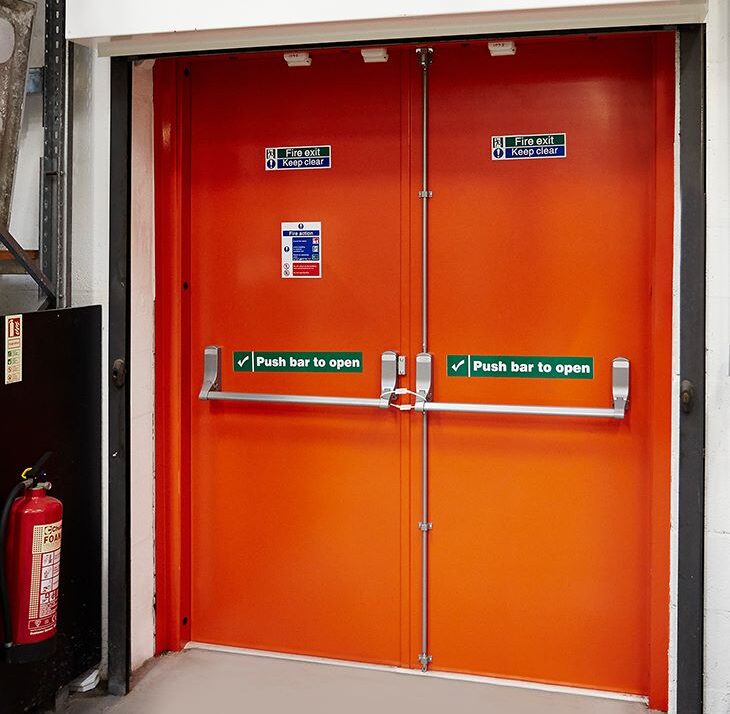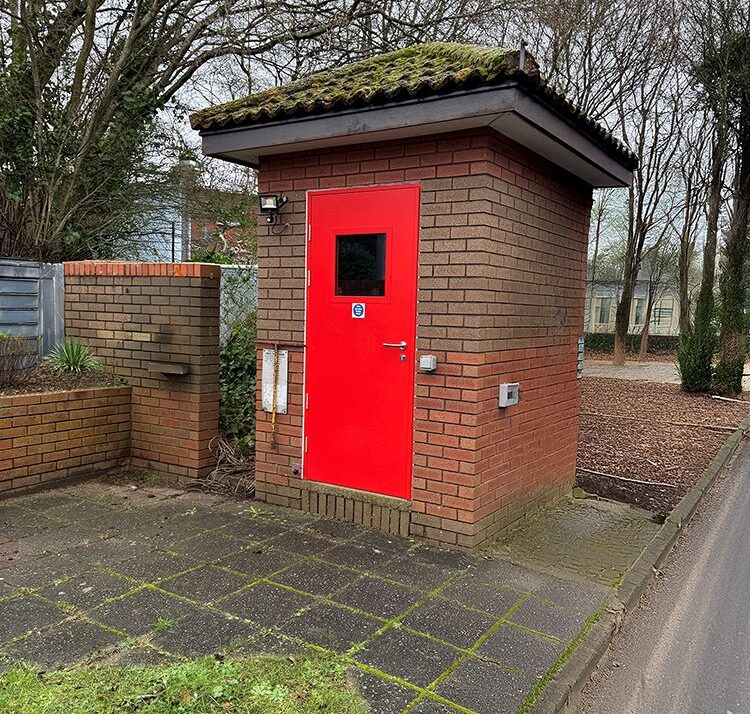Contact
Find Us
Metador Ltd,
Britannia House,
John Boyle Road,
Middlesbrough,
TS6 6TY
Contact
Find Us
Metador Ltd,
Britannia House,
John Boyle Road,
Middlesbrough,
TS6 6TY
Metador’s steel fire exit and emergency exit doors are designed specifically for safe, quick, and reliable emergency escapes. Manufactured right here in the UK, our doors ensure compliance, security, and peace of mind for commercial and industrial properties.
Whether you’re outfitting a new building, upgrading existing infrastructure, or improving security, our range of fire exit doors provides unmatched quality and trusted compliance.
Not every building is legally required to have fire exit doors or emergency doors, but if your property has employees, visitors, or customers, there’s a good chance you do.
Under the Regulatory Reform (Fire Safety) Order 2005, UK employers and building owners are responsible for ensuring people can escape safely in the event of a fire or emergency. That often includes providing clearly marked and unobstructed exit routes, sometimes with designated fire or emergency exit doors.
These doors must be clearly marked, kept unobstructed, and easy to open without a key or code from the inside. Doors must also open in the direction of escape if more than 60 people can use them at once.
If you’re unsure, Metador’s team can help you determine whether your building needs certified emergency or fire exit doors — and which type is best suited for your needs.
The terms fire exit door and emergency door are often used interchangeably, but they aren’t always the same thing, especially when it comes to building regulations and use cases.
Fire exit doors are specifically designed to provide a quick and safe means of escape during a fire. They are usually positioned along designated fire escape routes and are required to open easily without the use of keys or special tools.
Most fire exit doors feature panic hardware, such as push bars or pads, and are often marked with clear signage. In some cases, they may also be fire-rated, meaning they can withstand fire for a specific period to help contain it.
However, not all fire exit doors are fire-rated; their primary function is to enable fast evacuation.
Emergency doors, on the other hand, is a broader term that refers to any door intended for use in an emergency, not only fire. This could include evacuations due to gas leaks, security threats, or power outages.
Emergency doors might not always require the same panic hardware, depending on who is expected to use them. For example, in staff-only areas, a simple lever handle or push-pad mechanism (certified under BS EN 179) may be sufficient.
The key difference lies in who will be using the door and under what conditions:
You might also encounter emergency exit doors under names like:
Metador offers all types of compliant doors, so whether you’re specifying for public spaces, private facilities, or industrial sites, you can be confident your doors meet the right standards.
There are no two identical businesses, which means that one-size-fits-all is not a good solution in emergency doors.
This is why Metador offers extensive flexibility in door configurations. Here are some examples, based on our most frequent requests from clients:
Not sure what you need? Let our experts guide you through our specifications.
Choosing the right emergency exit door isn’t about compliance alone. It’s also about reliability, quality, and ease of installation.
Here’s why architects, contractors, and businesses across the UK trust Metador:
Metador designs, manufactures, and assembles steel doors at our facility in Middlesbrough. Controlling the entire production process means consistent quality, flexibility, and faster turnaround times.
All Metador fire exit doors adhere to stringent British Standards (BS EN 1125 and BS EN 179). Independently tested and certified, our doors exceed regulatory requirements, which means that your compliance is guaranteed.
Read more about our certifications here.
Need specific dimensions, finishes, or hardware configurations? Metador emergency doors are available with numerous customisation options, from colour and security features to unique sizing, without extending lead times.
Our doors incorporate multi-point locking systems, robust steel construction, and anti-tamper hardware to resist forced entry, enhancing security without compromising emergency egress.
Our team of technical specialists are ready to provide detailed advice, from initial specification through installation. We ensure the doors you choose align perfectly with your requirements and safety regulations.
From panic escape doors to regular emergency doors, there’s an application for each type of door we offer. We offer emergency doors for any type of premises, including but not limited to:
Retail stores, shopping centres, and commercial buildings use Metador doors for their blend of safety, ease of use, and secure construction, protecting stock and staff.
Factories and industrial units choose Metador fire exit doors for their robust build, resilience to heavy use, and reliability under emergency conditions.
Schools, colleges, and universities require dependable emergency exit solutions. Metador doors deliver both security and fast egress to keep students and staff safe.
Whether for individual houses or apartment buildings, the Metador steel doors offer the ideal combination of style, functionality, and safety.
Emergency exits must be secure yet easy to operate during emergencies. At the same time, you need to make sure that they don’t represent a weak spot in your building’s security.
Metador steel fire exit doors achieve both, offering:
Choosing Metador means choosing peace of mind, robust security, guaranteed compliance, and exceptional UK-made quality. Talk to our experts today and find the perfect fire exit doors for your project.
Not always. Fire exit doors must facilitate quick evacuation but aren’t always fire-rated unless specifically required to restrict fire spread. Metador offers both fire-rated and non-fire-rated emergency exits depending on your specific compliance needs.
BS EN 1125 requires panic bars for public buildings, while BS EN 179 covers push-pads or lever handles for non-public environments. Metador supplies both solutions based on your building’s usage.
They can’t be locked from the inside in a way that restricts escape. Metador emergency exit doors feature secure external locking systems with compliant panic hardware internally.
Metador doesn’t install directly, but we partner closely with trusted, accredited installers nationwide and can recommend installation specialists familiar with our doors.
Technically, yes, but it’s not recommended. Fire exit doors are designed for emergency escape, not daily use. Using them regularly can cause unnecessary wear on panic hardware and may compromise their emergency function. If you need dual-purpose access, speak to us about configuring a fire exit with external access control.
Yes. UK building regulations state that emergency exits must open in the direction of escape—that is, outwards—especially in buildings where more than 60 people may be evacuating. This reduces the risk of congestion or injury during an emergency.
You can have external locks, but the door must always open freely and easily from the inside without the use of a key or code. Metador fire exit doors are fitted with panic bars or push pads internally, ensuring escape routes remain accessible at all times.
There’s no legal requirement for a specific colour, but green is typically associated with emergency exits due to UK safety signage standards. However, Metador offers a full range of RAL colour options so you can balance compliance with your building’s aesthetics.
Fire exit doors should be inspected regularly (ideally every six months) to ensure hardware works correctly, doors aren’t obstructed, and signage is intact. Metador doors are low-maintenance, but we recommend scheduling inspections as part of your building’s fire safety plan.

